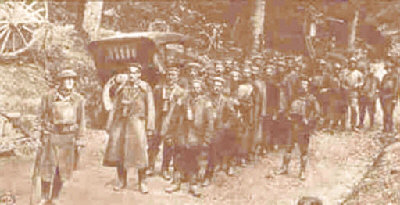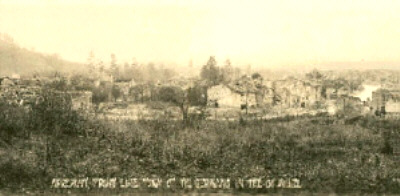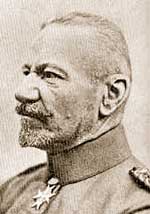The Story of the American Expeditionary Forces |
 79th "Lorraine" Division |
The Strategic Threatpresented by theThe AEF |

German Prisoners Captured
The First Day of the St. Mihiel Offensive

|
The shortcomings in military efficiency and tactical doctrine discussed elsewhere on the Doughboy Center (click here) are often inflated by present-day historians to suggest a top to bottom incompetence in the AEF. The answer to this is that the AEF was learning its job. At times like at Soissons excessively high casualties were taken. In the opening phase of the Argonne the wheels fell off the wagon and the First Army slowed to a creep. But these matters were corrected by Pershing and his more able lieutenants like Hunter Liggett who were rising to top commands of the armies, corps and divisions. But as it learned and evolved, just how important was the AEF getting in the equations of battlefield power?
A broader way of asking this question is: Did the Germans commanders ever feel concretely threatened by the AEF? A September 1918 German staff analysis discovered after the war seems to address this issue. It's signatory is General Max von Gallwitz, a successful commander during the earlier conquest of Serbia, who was to command the Army Group facing the main American forces in latter 1918. He is observing, first hand, the constant growth of the AEF. He sees this fresh manpower giving Marshal Foch more latitude in where he could strike next. Gallwitz and his staff believe Foch will eventually see growing vulnerability of German forces and Germany proper to an allied assault through the Lorraine. The fact that this happens to be where those growing American forces are being deployed goes unsaid. Editors comments are in italics. [Enemy] Estimate of Situation Preceding St. Mihiel Attack September 11, 1918 From: Operations Section GROUP OF ARMIES GALLWITZ, To: General Headquarters I desire to submit the following estimate of the situation:
Here General Gallwitz sees the St. Mihiel Offensive is imminent: From numerous indications and reports it is apparent that an enemy attack, mainly American, is imminent against the south front of Composite Army C; lately such an attack also appears to be shaping against its west front. Such an operation seems highly probable in view of the general situation. The difficulties for the British and French for advancing to Germany. After the withdrawal and restabilizing of our main battle fronts the enemy high command may very well say that we are using every effort to rebuild and increase our strength and there still is considerable work ahead of them on our west front, for which the remainder of the season would hardly be sufficient. But even if there were enough time, the way via the front LILLE---CAMBRAI---ST-QUENTIN---LAON and across the different rivers and lines of fortifications of Belgium would decidedly be a rather long one, before the Entente could get the war out of its own country and would be able to do any great damage to us. This way would have to be fought by the Entente with fighting over devastated French territory and a Belgium in ruins. The vulnerable point is in the Lorraine. Therefore it is obvious that the enemy will attempt to find a vulnerable point, not only of our front but of our country, which can be reached more easily and quickly. Such an opportunity would be offered by invading LORRAINE against the Nineteenth Army. The enemy would be on coveted soil which he wants to liberate, he would threaten one of our most important lines of communication, as well as the SAAR coal and industrial region. Moreover a sally from the region of VERDUN offers the prospect of paralyzing our utilization of the BRIEY Basin and would likewise endanger one of our most important lines of communication. The two operations combined, enveloping METZ, would drive a wedge into our country which would not only be effective, but which also would seriously influence the conduct of the fighting on the northwest front, in a manner that would prove to be less expensive to the enemy than an attack on that front. This is where the AEF comes in handy. Marshal Foch can make available the forces needed for this operation by using the ever-increasing number of Americans and by employing his reserves in such a manner that the English front would continue to be supported by him, but only weakly and more as a diversion. Here Gallwitz justifies the withdrawal from the St. Mihiel Salient that he has already ordered. This sounds a bit like bureaucratic C.Y.A. language. Regardless of whether the enemy chooses one front or the other for the breakthrough, or both of them, in any event our triangular St-MIHIEL front would represent the first inconvenience to be gotten out of the way and it also would represent the first object of attack promising success. To speak bluntly, the defects inherent in the triangular salient of Composite Army C invite attack. Its evacuation before a large-scale attack is necessary and has been initiated. This triangle having been eliminated, with or without a fight, the enemy would find himself in front of a line more in our favor, but he would have greater freedom of movement than before. He would be in a position to carry out his attacks. On the left flank the Michel Position is of a nature lending itself to defense but here too it presents a salient. In the center the situation is passable. The right flank, approaching the heights of the MEUSE and at times uncomfortably close to them, represents a weakness, the same as the left flank of the Fifth Army. To hold the position at that particular point for any length of time will be possible only by making considerable sacrifices. A suitable rearward position for Composite Army C is lacking. Suggests a strategy for meeting any breakthroughs in this sector. It must be expected that the enemy will effect a breakthrough in the region of ETAIN. Here the defense cannot be conducted in a rigid manner but must be active in the fullest sense of the word. As I see it. the defense should be organized by holding in readiness in rear of the left flank of the Fifth Army and the right flank of Composite Army C, powerful attack elements: these would not execute any frontal counterattacks but would fall upon the flanks of the hostile penetration, which should even be led into the trap. This would not only assist the defense but would also result in a rather considerable tactical and moral success.  Apremont: Captured on the First Day of the St. Mihiel OffensiveTherefore I consider it a probability to be deduced from the general situation that the large-scale battles on the west will soon be followed by events of equal, perhaps decisive, importance on the fields of LORRAINE. Now, it may be objected that the gates of invasion have been open to the enemy for a long time, without his using them. But here- to-fore the enemy had no forces available for this purpose. Now he can afford such a large- scale assault, without inadmissibly stripping the English-French front [Ed. note: because of the availability of American Troops]: neither the channel coast nor PARKS [?] is being threatened at present. Furthermore Marshal Foch seems to me to be skillful enough to turn away from an objective that is growing more difficult to gain, before it is too late, and to attack the enemy at a weaker spot. I desire to submit these remarks with the request that they be examined from the standpoint of your better-informed judgment, and if they are found to contain any material meriting consideration, that they be taken into account at the proper time in the assignment of troops. In this connection may I invite attention to the fact that among the front line divisions of this Group of Armies, there is a rather large number of divisions not completely fit for front line employment, and that those recently attached were entirely exhausted. General Max von GALLWlTZ Commander Army Group C (Meuse-Moselle Sector) Foch apparently was thinking as Gallwitz suggested he would. He already convinced Pershing to attack in the Meuse-Argonne after flattening the St. Mihiel Salient. By the end of October a third offense launched from the base of the reduced St. Mihiel Salient was in planning for November 14th. Preliminary operations were underway when the Armistice halted operations. After reading this document and reviewing what transpired during the last months of the war, it is hard not to conclude that the AEF was the greatest immediate threat faced by Germany on the battlefield. And in 1919 2 million more doughboys would be arriving. |
|
|
To find other Doughboy Features visit our |
Membership Information  Click on Icon |
For further information on the events of 1914-1918
visit the homepage of |
Michael E. Hanlon (medwardh@hotmail.com) regarding content,
or toMike Iavarone (mikei01@execpc.com) regarding form and function.
Original artwork & copy; © 1998-2000, The Great War Society
